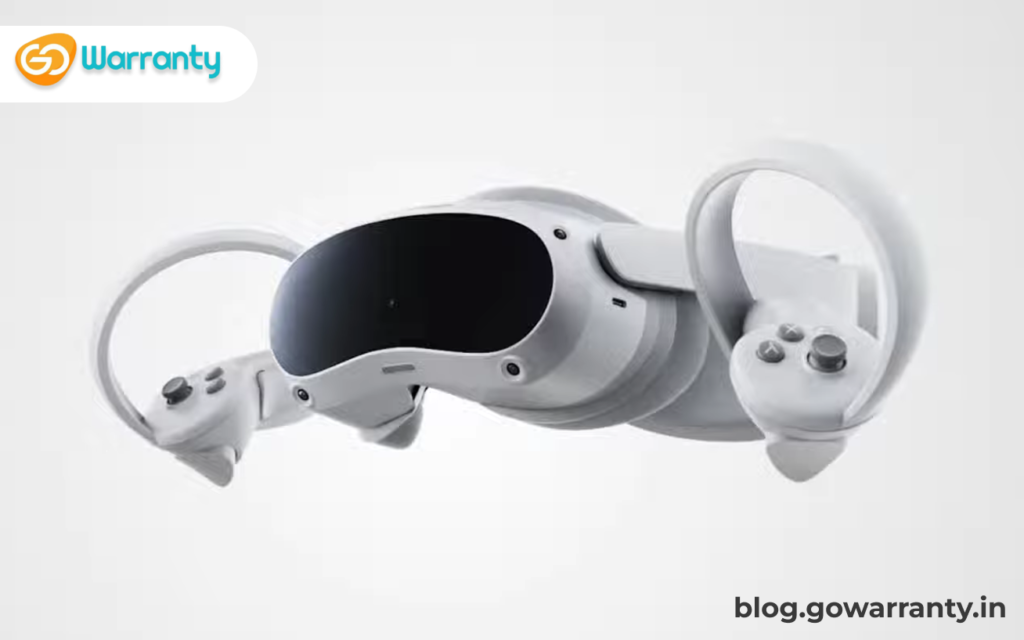Many of the Pico 4 advantages are only on paper. In practice, the higher resolution and wider field of view are barely noticeable. On the other hand, the image suffers from smearing or ghosting, as well as reflections in high-contrast areas. The screen-door effect is clearly visible, thanks in part to “bubbles” or “holes” that appear irregularly in the pixel grid. The image appears dark in general, with washed-out colours. God-rays, on the other hand, are largely extinct. Positives include the smaller form factor and significantly lower weight. However, any comfort gain from the lighter weight is immediately negated by a subpar head strap design.
Setup and Battery
Setting up the Pico 4 is nearly identical to setting up a Quest 2. (review). The VR headset, including the gaming area, is quickly set up with the help of videos and step-by-step instructions. Logging into a Pico account is required for setup. This is not possible through the app, nor is it possible to configure the Wi-Fi network. At the very least, I don’t have to remember my payment information because I keep it in the VR Assistant app.
The battery life is comparable to that of the Pico Neo 3 Link or Quest 2, lasting about two hours before needing to be charged. Unfortunately, Pico only provided me with a British plug for the novel charger, so I can’t comment on the allegedly quick charging time. With a standard charger, it still takes about an hour and a half to two hours.
Resolution and Colours
Pico 4 has a higher resolution per eye of 2,160 x 2,160 pixels than Pico Neo 3 Link and Quest 2, but the difference is barely noticeable in practice. When I look closely, I believe I can see a slight improvement in readability. In comparison to the Quest 2, the colours on the LC display appear washed out and darker overall. This is most likely due to the new pancake lenses, which are significantly larger than previous Fresnel lenses and lack the typical Fresnel rings.
Field of View
The larger field of view is one advantage of the new pancake lenses. I’m not even going to get into the seven or ten degrees wider field of view that Pico 4 claims over the Quest 2. My eyes are much closer to the display that they used to be because of the large, flat lenses. As a result, at first glance, the field of view appears much larger.
However, in the same VR scene, a direct comparison with the Quest 2 discloses that the slightly larger field of view is barely visible. That is also why I consider marketing nonsense and a waste of time discussions about numbers in resolutions or fields of view that are relatively close to each other. In practice, an increase of 250 pixels or five degrees makes no difference. The image clarity in the centre, or “sweet spot,” is exceptional.

Comfort
When it comes to comfort, the Pico 4 VR headsets leave a lot to be desired. The reason, in my opinion, is the manufacturers’ tunnel vision. While the new pancake lenses on the visor (i.e The front portion of the headset) ensure noticeably less pressure on the face, the fitting stability is completely ignored. The standard strap on the Quest 2 is an imposition, and it requires the Elite strap or comparable accessories to fit comfortably.
Pico 4 relies on a non-interchangeable plastic halo head mount rather than learning from their (and Meta’s) experience. The issue is the back of the head plate, which cannot adapt to different head shapes. While the Quest 2’s Elite Strap head mount adapts to any head shape and thus provides a secure fit, I can only clamp the Pico 4 to my head using the adjustment wheel.
Tracking
Tracking is once again flawless, and I barely notice any differences from Quest 2. The controllers track precisely even during fast movements in VR games. The new VR controllers have only one minor flaw: new tracking brackets that run over the thumb near the end of the VR controller. These tracking points can be easily covered at times, such as when I simply let my hands hang with the controllers.
Sound and Software
Pico 4 lacks a jack plug for headphones. The speakers are built-in and produce mostly good sound. However, sound enjoyment does not appear, and they occasionally appear to overdrive. However, the dual microphones are subpar. In a test with colleagues, the transmission was unpleasant, similar to talking from a long distance on an old phone.
In terms of software, the Meta-inspired interface is nearly identical. Those who have played Quest 2 will be familiar with the Pico menu. It also works very well. So far, I haven’t encountered any bugs.
Wireless with Wired SteamVR streaming
I can access SteamVR using the Pico Link software on my PC as well as the VR streaming app on the Pico 4 if I have a WiFi-6 capable router or access point properly configured.
There are three options: “Smooth,” “SD,” and “HD.” The “Smooth” option is probably primarily concerned with performance. It works well and smoothly, but the graphics are muddy as a result. “HD” on the other hand, depending on the application, looks good and runs surprisingly smoothly.
Verdict
Hardware enthusiasts applaud the pancake lenses and reduced weight of the VR headset. High-contrast areas, on the other hand, cause smeared glare or a reflection effect on the lenses. Those who value comfort will appreciate the weight savings; however, the unsettling head mount remains one of the Pico headsets’ major flaws in my opinion.

